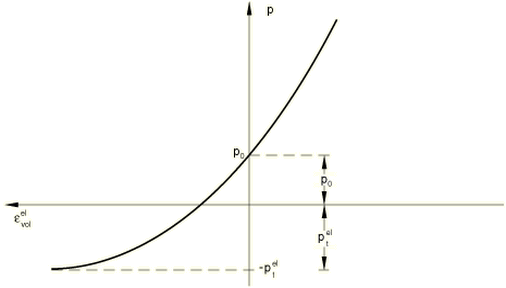Logarithmic Porous Elasticity Model
The logarithmic porous elasticity model is valid for small elastic strains (normally less than 5%). It is a nonlinear, isotropic elasticity model in which the pressure stress varies as an exponential function of volumetric strain. The model allows a zero or nonzero elastic tensile stress limit.
Defining the Volumetric Behavior
Often, the elastic part of the volumetric behavior of porous materials is modeled accurately by assuming that the elastic part of the change in volume of the material is proportional to the logarithm of the pressure stress (Figure 1):
where is the “logarithmic bulk modulus”; is the initial void ratio; p is the equivalent pressure stress, defined by
is the initial value of the equivalent pressure stress; is the elastic part of the volume ratio between the current and reference configurations; and is the “elastic tensile strength” of the material (in the sense that as ).

Input File Usage
Use all three of the following options to define a porous elastic material:
POROUS ELASTIC, TYPE=LOGARITHMIC,SHEAR=G or POISSON to define and INITIAL CONDITIONS, TYPE=STRESS to define INITIAL CONDITIONS, TYPE=RATIO to define
Abaqus/CAE Usage
Use all three of the following options to define a porous elastic material:
Property module: material editor: : Type: Logarithmic
Load module: Create Predefined Field: Step: Initial: choose Mechanical for the Category and Stress for the Types for Selected Step
Load module: Create Predefined Field: Step: Initial: choose Other for the Category and Void ratio for the Types for Selected Step
Defining the Shear Behavior
The deviatoric elastic behavior of a porous material can be defined in either of two ways.
By Defining the Shear Modulus
Give the shear modulus, G. The deviatoric stress, , is then related to the deviatoric part of the total elastic strain, , by
In this case the shear behavior is not affected by compaction of the material.
Input File Usage
POROUS ELASTIC, TYPE=LOGARITHMIC,SHEAR=G
Abaqus/CAE Usage
Property module: material editor: : Type: Logarithmic: Shear: G
By Defining Poisson's Ratio
Define Poisson's ratio, . The instantaneous shear modulus is then defined from the instantaneous bulk modulus and Poisson's ratio as
where is the logarithmic measure of the elastic volume change. In this case
Thus, the elastic shear stiffness increases as the material is compacted. This equation is integrated to give the total stress–total elastic strain relationship.
Input File Usage
POROUS ELASTIC, TYPE=LOGARITHMIC, SHEAR=POISSON
Abaqus/CAE Usage
Property module: material editor: : Type: Logarithmic: Shear: Poisson